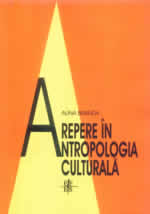Ana-Elena Ilinca
| Key
Words: cultural anthropology, symbolic system |
MA Faculty of Letters |
Alina
Branda
Repere în antropologia culturală
Orientations in Cultural Anthropology
Ed. Fundatiei pentru Studii
Europene, Cluj-Napoca, 2002, 272p
| previous |
The book Orientations in Cultural Anthropology by Alina Branda, which I have chosen to review has drawn my attention due to its character of novelty in the Romanian cultural context. Just as the author herself stated in the Foreward of her book, this book stands for “an approach of diachronic and synchronic identification of the major stages” regarding cultural anthropology. It is also a “pleading” for establishing the studies of cultural anthropology in Romania. The author places her arguments within the framework of broader theoretical trends which one could identify in this domain. Therefore, in the first chapter of the book, she discusses the main JSRI • No.5 /Summer 2003 p. 214 tendencies of cultural anthropology since it has gained the status of a well-established science. On the one hand, this chapter is a critical comparison of the major anthropological trends and schools. On the other hand, it has a systematic dimension that introduces the inquisitive reader into a field that places Man at the very heart of culture. Alterity is a key-concept in cultural anthropology, and thus, the author pays tremendous attention to that issue, as one could assert that knowing the Other has always been the main goal of the anthropological research. The second chapter of this book analyzes the relations between cultural anthropology and other social sciencies such as sociology, linguistics or philosophy. What is interesting about cultural anthropology is its distinct feature of being an “open” science. It is underlined its character full of paradoxes and dilemmas, and its propensity towards borrowing from related sciences. To researchers this may be a source of great distress, as well as a unique way of asserting a dynamic and challenging science. An extensive sub-chapter deals with fieldwork which represents a major foundation for this particular field of study. It stands for both a basis of information and a source of experience which shape the researcher in cultural anthropology. What is noteworthy is the fact that fieldwork is carried out differently by the various anthropological schools, and as such it provides different outcomes, and produces different types of anthropological discourse. The author continues her analysis by considering several of the most important theories corresponding to cultural anthropology. Consequently, the third chapter is dedicated to the presentation of functionalism as envisaged by Bronislaw Malinowski, of symbolic anthropology and its interpretative paradigm, and of cultural relativism. Malinowski’s functioinalist approach privileges the social system, especially the mechanism of human necessities. He focuses on concepts like function and structure which are considered to be at the basis of the social life. One of the main alternatives posed to this kind of approach comes from symbolic anthropology. This type of analysis views culture as a symbolic system. It articulates the importance of cultural symbols and their meanings within the framework of the social life of the group. The cultural relativism perspective values the diversity of cultures. It includes different forms and types of relativist approaches. It has positively influenced the theories and the methods existing in contemporary cultural anthropology. It may also present the risk of a unilateral judgement of different cultures. A. Branda concludes her book with an analysis concernig the relation between the Western cultural JSRI • No.5 /Summer 2003 p. 215 anthropology and the similar researches that are carried out by the South-Eastern European specialists, namely ethnography and ethnology. From the very outset of the last chapter, the author points out that one cannot speak of cultural anthropology in South-Eastern Europe, as, here, the main approaches have been of ethnographical and ethnological nature. There is a fundamental difference between the two traditions both in approach and in methodology. Further on, the author identifies the main and complex causes of the gap between the two traditions. She also underlines the need for the South-Eastern European researchers to adjust themselves to contemporary research which is conducted in this field nowadays. Special attention is given to the Romanian case. Although this work was first written as a PhD thesis, the term which may fully depict this book would be “the bird’s eye view”, as it aims at providing an integrative presentation of what cultural anthropology represents. It may very well be considered an attempt which is intended to awaken the awareness of the Romanian public on this kind of topic. The lengthy bibliography attatched at the end of the book gives the reader the opportunity to become more familiar to this domain. JSRI • No.5 /Summer 2003 p. 216 JSRI • No. 5/Summer 2003 |
| previous |
